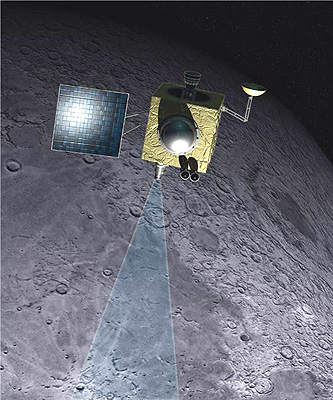[/caption]
India’s lunar orbiter Chandrayaan-1 lost contact with ISRO’s ground station early on August 29. “We are not able to establish contact with the spacecraft. We are not getting the data, we are not able to send commands,” an ISRO official told the Press Trust of India. “In simple terms, the spacecraft has become dumb. It can’t speak.” The 11 scientific payloads onboard the orbiter had been operating normally, and the spacecraft was sending data during a planned sequence to its ground station when contact was lost. Officials are now analyzing data obtained, hoping to find any indications of what could have happened.
Chandrayaan 1 and NASA’s Lunar Reconnaissance Orbiter teamed up on August 20 to perform a bi-static radar experiment, and although no results have been released yet, the data had been successfully returned from the test.
Chandrayaan-1 was launched October 22, 2008, reaching the moon in early November. It has made over 3,000 orbits and its high-resolution cameras relayed over 70,000 digital images of the lunar surface, providing breathtaking views of mountains and craters, including those in the permanently shadowed area of the moon’s polar region.
The Times Now website is reporting that the mission is over, with a quote from Project Director of the Chandrayaan-1 mission, M Annadurai: “The mission is definitely over. We have lost contact with the spacecraft.”
He added “It has done its job technically…100 per cent. Scientifically also, it has done almost 90-95 percent of its job.”
But as of this writing it has only been about 18 hours since contact was lost. We’ll keep you posted on further news on Chandrayaan-1
Hat tip to Svetoslav Alexandrov


Well, that sucks! But India showed all of us what a creative nation can do.
Rest in pieces, Chandrayaan-1. [I assume all close moon orbiters will eventually crash due to the gravity inhomogeneities?!]
Its still impressive for a first attempt.
My question would be how long can the satellite go without a direct command before tumbling into the moon or otherwise becoming unrecoverable?
Eighteen hours in seems kind of early to declare it a loss.
Or maybe, some sort of “secret” agenda?!………………..
If they did anything right with the design, it should be tumbling and power positive with periodic transmitter on/off commands. That or it’s the unfortunate victim of a collision. Still 18 hrs is long for there to be no contact.
Seems serious – I have a special interest in C1XS, the spectrometer which relies on X rays from an active Sun to analyse the Moon’s geology without ever setting “foot” on the surface.
Seriously disappointing.
Seems odd that after merely 18 hours without contact, they are already declaring the mission as lost. At least take a bit of time to analyse the anomalous behaviour to ensure that it is in fact beyond redemption…
Good to hear that it has accomplished most mission goals, and that the recent collaborative radar experiment with NASA came off though…
surprise surprise!
Knew this was going to happen since its launch… just wasn’t sure when.
this was no accident.
it is the work of Naval Space Command(NAVSPACE).
for what?
speculate amongst yourselves. lol 🙂
(great site here btw!)
Out of curiousity, if something like this happened with China’s probe what would the responces be? Would it be anything like “it showed us what a creative nation can do”? Doubtful.
Speaking of which, how exactly did India show us what a creative nation can do? 6 out of 11 components were gifts from western space agencies, not their own design or even their own manufacture. Compare this with China’s orbiter, which carried more instruments and, IIRC they were indigenous (if I’m wrong about that last point please post some credible links, thanks).
@Outcast: Dude, you are right, but just think about how they leveraged the expertise of other space agencies to increase global knowledge, every data was open for scientist across the globe. China, at other hand, is closed.
BTW, do you think who can make 5 instrument, can not make remaining 6? moreover, the challenge was to send a satellite for moon, putting instrument is not a big deal.
FYI, look for BHUVAN, that shows ISRO’s capacity in terms of so called instruments in satellites.
They are taking baby steps and must be encouraged.
Let the science Win 🙂
“@Outcast: Dude, you are right, but just think about how they leveraged the expertise of other space agencies to increase global knowledge, every data was open for scientist across the globe. China, at other hand, is closed.”
China is generally banned from recieving most high tech stuff from the US because of American paranoia about losing our tech edge. Let’s also put into context that the Americans have effectively been blocking China’s participation (http://www.space.com/missionlaunches/china_plans_031016.html
“China doesn’t participate in the International Space Station, due in part to American unease about allowing a communist dictatorship a place aboard.”)
Given that it has been effectively backed into a corner, is it any surprise it went alone?